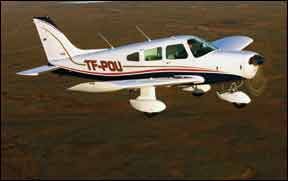In the largish universe of used airplanes, there are a handful that are often overlooked. One of these is Pipers Cherokee 140, the modest but nonetheless seminal model that literally launched a lot more than a thousand ships. The baby Cherokee was a variant of a model that marked Pipers no-looking-back departure from its rag-and-tube beginnings with the Cub. The basic concept proved a durable Baldur Sveinsson platform on which to build an entire company. Today, the Cherokee 140s is a bargain, selling for prices in the low- to mid-twenties, with plenty on the market and a boatload of mods and options to upgrade them. The airplanes Lycoming O-320 was a good choice for the airplane and gave the original PA-28 surprisingly good performance. Yet…buyers often overlook these models in favor of the newer Warrior or the 180/Archer line, which are both more expensive and more airplane than many people trying to get into flying on the cheap really need.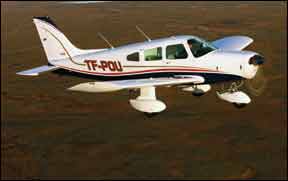
By the early 1960s, Piper had run its course with the rag-and-tube thing. The Cub was long over, although the Super Cub was a hot selling replacement, and the Tri-Pacer was dated and dowdy. Furthermore, Cessna was eating Pipers lunch with the 172, 180 and 182.
So in 1962, Piper went radical, dropping the rag-and-tube construction used on the Cub and Pacer and switching to an all-metal, low-wing design with advanced features such as oleo-strut landing gear and an all-flying stabilator. It was downright futuristic compared to the Tri-Pacer, and even made Cessnas Skyhawk look old-fashioned.
The new model wasnt actually the 140, but the the PA-28-160. It was the brainchild of John Thorp, who also designed the innovative T-18 homebuilt, among other designs. The PA-28 was to spawn a remarkably diverse family of airplanes, ranging from the Cherokee 140 all the way up to the Turbo Arrow IV. Even the Cherokee Six, although a distinct type, owes its birth to the humble PA-28 series. All PA-28s share the same basic design, which through its simplicity has proven to be durable and easy to maintain. Check the ads in
Trade-A-Plane and youre likely to see Cherokee 140 examples with 8000 or more hours still in daily service. Airplanes don’t accumulate that kind of time unless the design and structure are sound and easily maintained.With Cessna coming on strong in the trainer market, Piper needed an inexpensive entry-level trainer. In 1964, the PA-28-160s rear bench seat came out and a climb prop that effectively de-rated the engine to 140 HP through a limit on RPM was added.
It was basically the same idea that decades later resulted in the last downmarket PA-28 variant, the Cadet: Offer a stripped-down, low-cost version of an airplane already in production and pitch it to flight schools.
The results were mixed. Yes, the extra space in back was nice, but the 140 didnt do what the Cessna 150 did. For one thing, the 150-HP engine was more expensive to operate and maintain than the Cessnas O-200. Second, the 140 didnt handle like the ideal trainer. It had a mushy stall and less-than-crisp slow flight qualities.
Nevertheless, the 140 proved popular. While the Cherokee 160-and its sibling the Cherokee 150-was dropped after the 1967 model year, the 140 remained in production for 13 years before it was superseded by the Warrior. Some 10,213 were built.
In 1965, another prop was installed which allowed the full 2700 RPM and restored the missing power. A gross-weight increase was allowed and a removable bench seat was installed, yielding, well, a Cherokee 150, more or less. The rear seat was only good in a pinch, but the competing Cessna 150 didnt have that option at all. In any case, the rear seat was a good stuff catcher that pilots liked.
The design remained essentially static until 1969, when the B-model appeared. It sported the now-standard Piper throttle quadrant, a T-instrument panel and other minor changes. An upscale Cruiser model was introduced with real rear seats, not just the make-do bench, and wheel pants. The C-model in 1970 had a better engine mount that reduced vibration, overhead air vents and Pipers adjustable seats. In 1971, The D-model got a new dorsal fin, inertial-reel shoulder harnesses
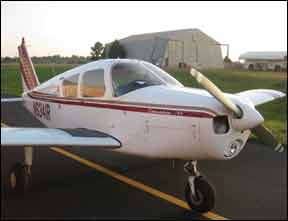
and an autopilot option.
The 1972 model year saw the last variant, the PA-28-140E. Optional air conditioning was offered, a unique feature in this class of airplane and probably not too desirable, given the power limitations. Subsequent model years had standard entrance steps, standard copilot brakes, and a redesigned steering linkage. The last 140s were built in 1977 and were dropped the following year in favor of the Tomahawk and Warrior.
Handling, PerformanceAlthough not the ideal trainer, the 140 is nonetheless easy to fly, if unexciting. Thats actually a good thing: Easy-to-fly airplanes have proven to be safer than those with sportier handling characteristics.
Of particular note is the Cherokees benign stall behavior. The fat Hershey Bar wing doesnt have a sharp stall break: Instead, it mushes along in the breeze, fighting the clean break.
In the opinion of some flight instructors, this isn’t desirable in a primary trainer because it doesnt teach the student much about how to recognize and deal with ugly or pronounced stalls. For the typical pilot, however, an airplane thats hard to stall is a definite safety plus.
The 140 wont set your hair on fire, speedwise. In fact, don’t even expect warm smoke. But for its class and power, its not bad. The low-aspect ratio wing is simple and strong, but its hardly good for climb performance. By the same token, glide performance isn’t so hot, either.
Owners have told us that control forces are a bit heavier than, say, a Warrior, but that the airplane is stable, making it a good instrument trainer. Typical real-world cruise speeds range anywhere from 96 to 102 knots, even though the book calls for 115 knots at 75 percent power. Pilots count on burning about 9 GPH at 75 percent, 7 to 8 GPH at 65 percent. The speed mods described on page 30 may considerably improve speed and economy.
The 140 has a fuel capacity of 50 gallons. Piper wisely installed tabs in the tank filler necks which indicate 36 gallons, making precise partial fueling easy. In fact, the standard fuel capacity was listed at 36 gallons, with 50 gallons optional-presumably to discourage overloading.
Ergonomics, CabinPiper obviously thought through many features on the Cherokee 140, but this yielded a mixed bag, in our estimation. We like the fully opening cowl, which makes a proper engine preflight easy. We don’t like screwed-down cowlings that make it impossible to see potential trouble in the engine room.
The panel layout in the later airplanes is generally good, although we would prefer engine instruments mounted closer to the pilots line of sight. The tachometer, for example, is down near to the throttle. Logical, perhaps, but the pilot has to take
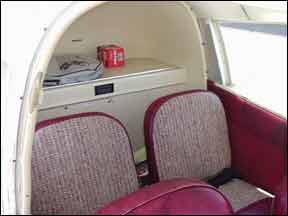
his eyes off the runway to make sure the engine is developing takeoff power. Cherokees have umbrella-style fuel tank caps, which have proven to be effective at keeping water out of the tanks. Flush caps rely entirely on O-ring seals, which degrade and eventually leak.
The fuel selector is located by the pilots left knee, on the sidewall. In later airplanes, its a large red handle with a positive spring-loaded latch that keeps it from being shut off inadvertently. Good design, but its located out of sight and therefore often out of mind. (Thats why fuel mismanagement accidents appear prominently in the accident record.)
Its also possible to switch to a position between tanks. We prefer the design used on the Tomahawk and the Grumman singles, in which the selector is located at the bottom center of the panel in plain sight, with a handle that points to the fuel gauge of the tank in use.
As noted, the later airplanes have good, adjustable seats that are more crashworthy than those found in many aircraft. Look for S-shaped frame tubes at the front of the seat. (The “S” bend allows the seat frame to deform in an impact, absorbing energy in the process.)
Compared to other two-seaters, the 140s cabin is large and comfortable, thanks to the fuselage it shares with other PA-28s. This is in contrast to the Cessna 150, which is tight with one person aboard.
If the Cherokees rear seat is used, there’s no separate baggage bay; if the airplane is treated as a two-placer, however, there’s lots of room for luggage. This makes the Cherokee 140 a much better proposition as an entry-level cross-country machine than a Cessna 150.
Cherokee 140s have only one passenger door, on the right side, and no baggage door at all. This makes an emergency exit problematical, particularly for those in the back seat. The door is the standard Piper two-latch design, with a latch lever near the armrest and a separate lever overhead. This should be pointed out and explained to passengers unfamiliar with the aircraft, since the pilot has to rely on them to open the door in an emergency.
One area where all Pipers shine is the flap control. Its a big manual lever between the front seats with a push-button latch. Its simple to use and its easy to see how much flap is out there. But it does take a hefty tug to deploy flaps.
Battery Box IssuesWorth noting is the design and location of the battery box. Its under the rear seat, adjacent to the spar. Its also adjacent to the fuel line for the right tank, which
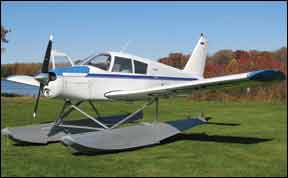
comes through the root rib and runs up along the bottom corner of the fuselage.
This arrangement has some interesting consequences. First, the area where the fuel line enters the cabin is lined with fiberglass insulation. This can sometimes trap water, especially since its near the door. The water can cause corrosion of the fuel line, resulting in a potential leak. The spark source? Jumping a dead battery on an airplane not equipped with a GPU plug.
The insulation has been cited by several owners: Its a good idea to pull out at least that part of the interior and check for corrosion and sodden insulation during a pre-purchase inspection. Also, check the condition of the battery box. Leaking acid in close proximity to the wing spar is bad news.
The battery box location also means a long run for the electrical cables. To save some weight, Piper used aluminum cables for a time. Most have since been replaced with copper, so check the airframe youre interested in for that mod.
Last, check the seat structure above the battery box. In one well-publicized 1981 accident involving a Warrior, the rear seat collapsed onto the battery box lid, starting an in-flight fire. The airplane landed successfully but the rear seat passengers were unable to egress and died in the fire. As a result of that accident, an emergency AD was issued calling for a plywood support under the back seat.
In an age when owners are growing irritatingly accustomed to the AD-a-week syndrome, the Cherokee 140 has relatively few significant ADs. Most are one-time or recurring-inspection-or-comply type directives. Our sweep of 200 service difficulty reports didnt reveal any discernible patterns other than those associated with airframes that are just old. As we did during our last review, we found clusters of reports related to corrosion in the spar, around fuel line fittings and on control parts. No specific parts seemed suspect, but clearly these older airframes will benefit from corrosion protection treatments. Cracked or leaking fuel vent hoses seem to be a common complaint.
While the O-320 is considered a reliable power plant, we found some failures related to loss of power for various reasons, including stuck valves, cracked valves and heads and carburetor issues. The SDRs didnt reveal any battery box or cable issues; we suspect these have been all but sorted out by now.
Mods, Owner GroupsSeveral companies make aerodynamic tweaks for the Cherokee. Notable are Laminar Flow, Knots-2-U, Horton, LoPresti and Power Flow.
Contact Laminar Flow and PowerFlow at 877-693-7356, www.powerflowsystems.com; LoPresti at 877-565-1731 and www.speedmods.com; knots2u at 262-763-5100, www.knots2u.com.; Horton at 800-835-2051,www.hortonstackdoor.com. The various companies make simple mods such as gap seals. Some (like Horton) make full-blown STOL kits, others (Laminar Flow) specialize in parts to enhance cruise speed. Power Flow makes a tuned exhaust system.
In the past, owners who responded to our reader surveys noted that theyd installed one or more mods, usually with at least some benefit derived. Whether
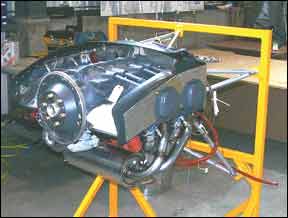
any particular mod will accomplish everything the manufacturer claims depends on so many factors that any promises should be looked at with clear eyes.
As with all airplanes, we strongly encourage potential buyers to join an owners club. The Cherokee Pilots Association can be reached through the umbrella Piper Owner Society at www.piperowner.org or 866-697-4737.
Owner CommentsWe bought our 1968 PA28-140 newly overhauled in 2004. It has a 160-HP engine, new interior and was repainted in 1998. It was a plain-Jane IFR-ready machine except for the addition of an old GPS100 at the top of the stack. The ADF had been removed.
We bought it because I was committed to getting my private pilots license, and it would be a good trainer as we’ll as a good XC machine up to 400 miles per leg. My wife and I routinely fly 400-mile trips from South Carolina.
After having it for about a year and a half, we thought about getting a larger airplane, but it was cheaper to modify this one to be a better cross-country plane for us and our primary visits with family. We added the back shelf option first, which more than doubled our cargo area by moving back the rear bulkhead about 8 inches and providing an upper hat shelf.
Now all of our bags fit behind the rear seats instead of piled high and under the seats. Cost: about $1500. We added the Lift Reserve Indicator to get a better performance edge on the grass strip we use in the heat of summer for about $1000. We added wheel pants and strut covers for better cruise. We can cruise 115 knots at 9 to 9.3 GPH or 110 knots at 8 to 8.4 GPH, depending on altitude and temperature. At lower speeds, we burn less fuel for training and joy flying. We replaced the GPS100 for a GPS 196 for about $1200, and had to rearrange the radio stack to accommodate the change. Our annuals run about $1200 a year and our instrument check runs about $750, unless parts need replacement.
We have had a few mechanical problems in the last six years but not that much. Had to replace the alternator twice, turn coordinator, altimeter, one radio, DG, landing light, strobe light, transponder, tach and starter. We had one cylinder fail after 300 hours. We have about 330 hours SMOH.
The aircraft is very comfortable and easy to fly and operate. I added a vernier throttle control and use it as a final trim adjustment so I don’t have to look at the ceiling mounted trim while I am flying. It trims easily to any desired speed, and the rudder trim is especially useful during cruise to take a load off your feet.
I trim side to side with fuel burn and can feel it when I need to switch tanks. A 400-mile trip with me, my wife, our dog and luggage takes 3:50 with no wind and burns 32.5 gallons of fuel. We came back against a small wind, left with 42 gallons, landed at 4:05, having 34.5 gallons burned, 7.5 gallons on board. Not bad for the little bird.
William “Pete” Hodges,
via e-mail
In 1977, I was 15 years old and my father, Dick Brower, had just bought his first
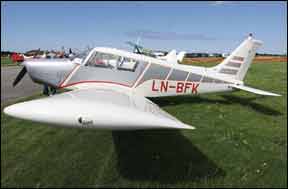
airplane, N5741F, a 1969 Piper Cherokee 140B. We went for a ride and my father couldnt stop grinning. My love of flying began that day. My father kept that airplane until I got my pilots license and he gave it to me. In addition to the emotional attachment that I have to my airplane, the Piper Cherokee is a great airplane to fly. It was developed to train pilots and, as a result, is stable and forgiving. Stalls are non-eventful and there is no wing drop. It is also good in crosswind landings and is a good cross-country flyer, having taken my father and me to Oshkosh over 20 times.
The Cherokee is fast enough to get somewhere in a decent amount of time, at 100 to 110 MPH, but slow enough to enjoy the ride. It is also a very economical airplane, using 7 gallons of fuel per hour. It has a useful load of 850 to 900 pounds and will hold 50 gallons of fuel, enabling it to fly much longer than you would want to.
It is also economical to service, with annuals approximating $1000 to $1500. While replacement parts have not necessarily been an issue, I find that because of the age of the airplane, upgrades, such as intercom systems, have increased the annual fee. Insurance is around $700 per year. The Cherokee is a little faster than a Cessna 150 or 172 and because of the low wing, it has greater visibility. It provides a stable flight, especially convenient when flying family and friends. My Cherokee is such a good airplane that I doubt I will ever trade up.
Alan Brower,
Califon, New Jersey
The PA28-140 is a great airplane–good performance at a good price, reliable, easy to fly and affordable to maintain. I bought my 140, N6341R, through broker Leo Smith (www.planesmithllc.com) of Eden Prairie, Minnesota, in August 2007. For first-time buyers like myself, shopping for a trustworthy broker may be a better use of time than shopping for a nice airplane.
A trustworthy broker will steer you to a good value and if youre reasonably cautious, youre likely to spend more on your own for pre-purchase inspections and post-purchase frustrations than you’ll spend to compensate the broker.
As for me, every aspect of ownership has been a joy, including the purchase experience, despite having purchased at the most recent valuation peak and about 15 minutes before the price of 100LL tripled. So OK, my timing could have been better. But my Cherokee is exactly what I was looking for. N6341R is a well-maintained 1966 Piper PA28 140/160. It spent most of its life in Minnesota, where it lived in a hangar and worked out regularly, but never served as a primary trainer. I keep it in a hangar in Orange, Virginia.
In my opinion, the hallmark of a well-maintained older Cherokee is compliance with Piper Service Bulletin 1006, which directs inspection of the wing spar behind the wing tanks every seven years for corrosion, treatment with anti-corrosive and replacement of fuel hoses while youre working in the wing. My airplane got its last SB1006 treatment from the previous owner in 2006; my first shot at it will be in 2013.
The airplanes interior appears to be original, but is in very good shape. The paint is good, with minor chipping here and there. The glass looks like new even though its not. My Lycoming O-320-E2A got its 160-HP STC in 1996, in the course of a field overhaul by Bolduc Aviation Specialized Services of Blaine, Minnesota (www.bolducaviation.com).
It purrs. It idles very smoothly, accelerates smoothly to redline and pulls all the way. This engine is as close to bulletproof as aviation engines get and stone

simple: a sturdy, reliable powerplant. The airplane currently has 5067 hours TTAF, 487 hours SMOH and is beautifully maintained by AP/IA David Cramer at Shannon Airport, in Fredericksburg, Virginia.
In addition to the 160-HP STC, 41R has a Skytec starter, Tanis heater, and an external power socket and cable which is good for maintaining the battery but not for starting the engine. In the panel, there’s one Bendix/King KX-155 navcom with glideslope, one Bendix/King 170B navcom, Mode C, an ADF (some rockin AM radio in West Virginia!), a two-place Flightcom intercom, plus something you don’t often see on vintage aircraft: an avionics master switch.
My airplane has its original panel; its a steam gauge airplane and I like it that way. Steam gauges are easy to read and interpret, cheap to maintain and have well-understood failure modes. The 140 has no toe brakes, only a hand-brake and I like that, too. With toe brakes, I worry about inadvertently engaging the brakes while working the rudders on landing; it happens and Ive seen lots of flat-spotted tires to prove it. My airplane is worry-free on this point. Handbrake operation is safe, effective, and the muscle-memory adjustment from toe brakes is fast and easy. An added plus is that the hand-brake system is about one third as complicated as the toe-brake installation on a 140, a comfort at maintenance time.
I flightplan at 9 or 10 GPH (10 for longer legs, just to be sure) and 100 knots. My actual numbers are better than my plan, usually between 110 and 115 knots on 8.5 GPH, but fuel mismanagement has been a problem for Cherokee pilots and conservative planning helps me avoid liberal excuse-making.
I also use a three-clock countdown stopwatch from Sportys to time fuel tank changes; when the third clock chimes, its time to land. I have the time and fuel to do it right. Im currently burning about a quart of oil every 8 to 9 hours with compressions in the mid to upper 70s all around. (I use AeroShell 15-50, change the oil every 25 hours and change the filter every 50.)
Annual costs have been high, about $2750 each so far, but should come down now that older hoses, baffling, tires and other wear items have been replaced and deferred squawks repaired. Thats the theory anyway. Insurance is about $850 per
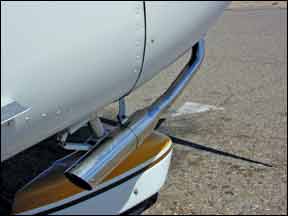
year for excellent liability and hull coverage, and has come down every year Ive owned the airplane.
The 140 is a joy to fly. Using the original, pre-STC weight and balance limitations, performance is always sprightly, even at max gross. Of course, even at 160 HP, the O-320-E2A is still a normally aspirated piston engine, so max-gross takeoffs on high density altitude days are best undertaken respectfully. Still, with a useful load of 867 pounds, I can fill 41Rs four seats with people of more or less normal sizes and have sufficient performance for safe operations under all but the most severe density altitude conditions.
With one or two souls on board, 41R gives me excellent hauling capability for an aircraft of this class, better than most, in my view. And although the single door and low wing can make loading feel like a yoga class, its easy to remove the rear seats with simple hand tools and arrange neatly whatever you can muscle through the door.
Climb performance varies from pretty good-about 1500 feet per minute at sea level lightly loaded on cool days-to sedate. At 9500 feet MSL on a hot day, 41R is stable and not at all twitchy, although the last 1000 feet takes over five minutes. Without an autopilot, cruise at any altitude is slightly more engaging than in a Skyhawk.
The airplane displays excellent stability in yaw and roll, but slight oscillation in pitch that requires constant attention. If you accept the pitch oscillation and the slow sine-wave deviation of about 100 feet in altitude that goes with it, the 140 can be trimmed and flown hands off, using gentle rudder pressure to hold the wings level against atmospheric vagaries. With a couple of fingers on the yoke and a little practice, the 140 can be flown with precision in all axes.
Landing the 140 is just too easy. It leaves us Cherokee pilots with few excuses. With the original Hershey bar wing, the Cherokee 140 has about zero tendency to float; pulling the throttle brings it down right now. The key to good landings in the 140, in my view, is throttle management: Set pitch and use the throttle to adjust glideslope. Carry a little power to the threshold and smoothly close the throttle while holding the nose up. The 140 rewards a well-judged flair with a satisfying chirp and protests a lesser effort with a resounding clunk, but the robust gear takes it all in stride either way.
In my opinion, the Cherokee 140 is the perfect blend of simplicity and capability. I heartily recommend a well-maintained older Cherokee 140 to anyone looking for basic aviation, classic good looks, simple, strong and proven metal construction, low costs and surprisingly fulsome capability.
Joe Corrao,
Fredericksburg, Virgin

